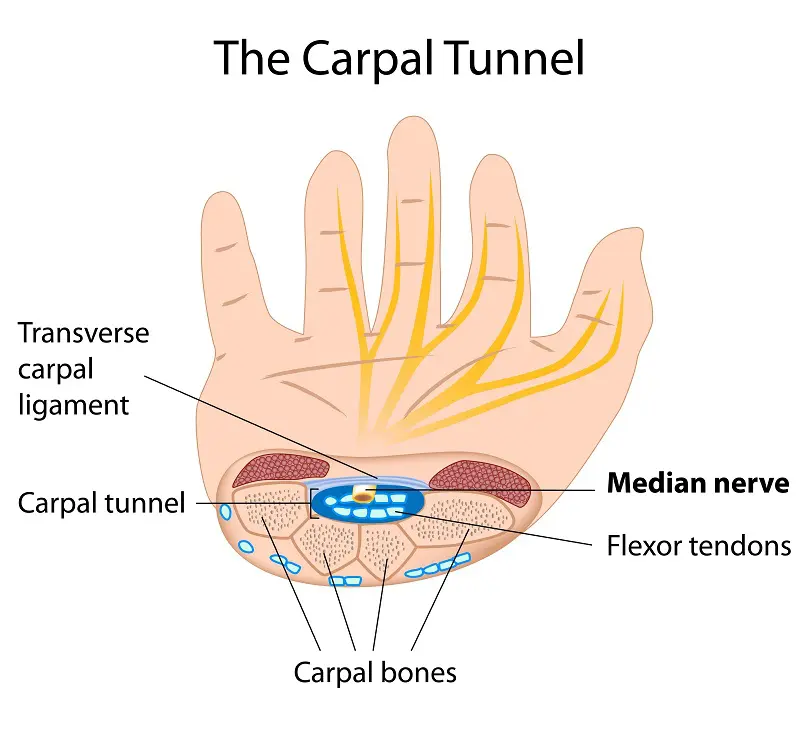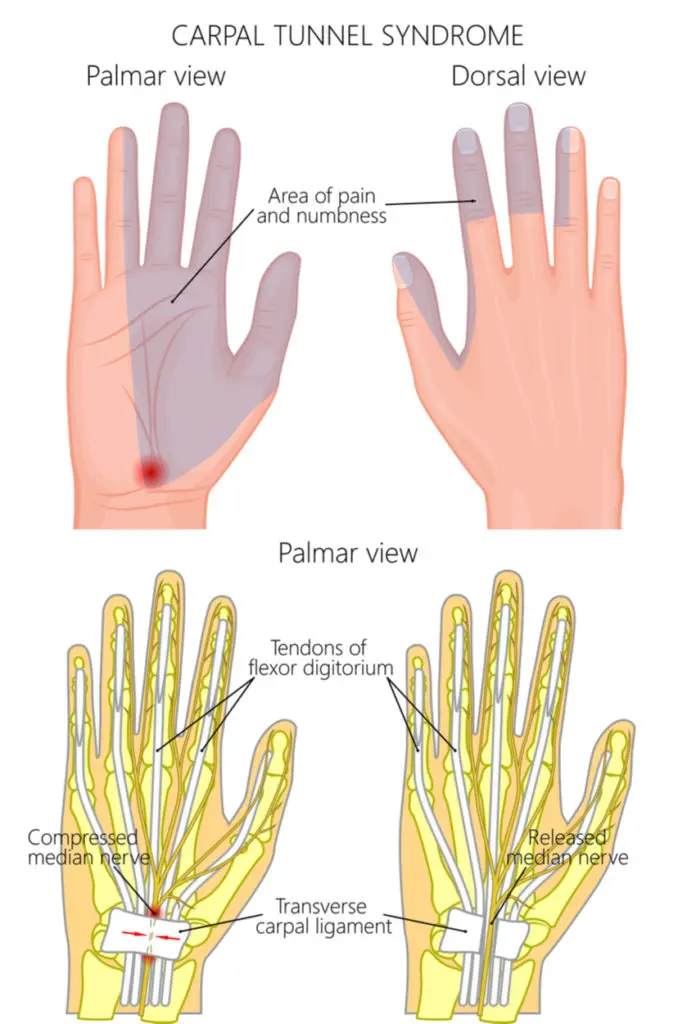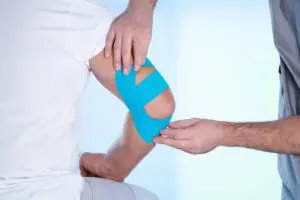
Written by Roger Morelli, Myotherapist
Carpal Tunnel Syndrome is a debilitating RSI (nerve entrapment) of the arm. It is the most diagnosed neuropathy of the upper body. Work tasks and posture are often the primary causes of Carpal Tunnel, however symptoms may also be caused by thoracic outlet syndrome (compression of nerves at the shoulder), pregnancy and diabetes.
Knead Myotherapy can assess the causes of your carpal tunnel pain and provide a rapid solution to symptoms. At Knead we use the latest scientifically validated methods including:
- Low Level Laser
- Electro Dry needling
- Nerve Mobilisation Techniques
- Expert Arm, Neck and Shoulder Massage
- Joint Mobilisations
- Movement strategies designed to stop pain and improve nerve health
- Ergonomics Advice
Many clinicians focus only on the arm and wrist. This is a mistake and leads to you endlessly paying for treatments. In fact the majority of carpal tunnel syndromes involve the spine and shoulder. Only focusing on the forearm, means you are only treating 30% of the problem.
In too much pain to read the whole article? Hit the book now button and resolve your pain with Expert Myotherapy.
Don't let carpal tunnel syndrome slow you down!
What’s carpal tunnel syndrome?
- The carpal tunnel is an access point in the wrist for nerves and blood vessels. An analogy might be a small conduit space for electrical cables to pass through a wall.
- The median nerve provides sensation to the palm side of your thumb and fingers. This allows the brain to activate the muscles that permit manual activity of the hand.
- The MEDIAN NERVE passes through this space. Carpal tunnel syndrome is largely caused by compression on the median nerve by swollen tendons and muscular structures.
BUT THIS IS NOT THE WHOLE STORY!
Restriction in the carpal tunnel can be caused by.
- Swelling in the tendons of the forearm
- Muscular compression in the forearm
- Restriction of the nerve at the shoulder and spine – (particularly the neck and upper back).
- Impingement and restriction of the nerve may cause many unpleasant sensations including – pain, tingling, numbness, weakness, loss of sensitivity, hyper sensitivity and a feeling of “swelling”
What carpal tunnel feels like?
Compression of the median nerve or compression at the shoulder (brachial plexus) may cause many unpleasant sensations associated with carpal tunnel including:
- Tingling
- Numbness
- Pain
- Weakness
- A loss of sensitivity
- An increase in sensitivity
- A feeling of swelling
Additionally these sensations can often be increased or decreased with positional variation, such as driving or tool use.
Night pain is a common feature of severe Carpal Tunnel.
Symptoms often worsen at night because sleeping on your side can further compress the nerves. In a curled position, circulation is reduced, and since the muscles aren’t actively pumping fluid through the area, swelling tends to build up in the arms more than when you’re moving during the day.
How carpal tunnel syndrome happens?
- If a structure compresses the median nerve in the carpal space this may lead to Carpal Tunnel Syndrome and sharp pain in the wrist.
- Postural factors that affect the neck and upper back can restrict the length/tension relationship of the nerves that give sensation and motor control to the hand. Neck and shoulder pain are usually a significant part in the development of Carpal Tunnel Syndrome.
- Apart from Repetitive Strain Injuries – common causes may include swelling from rheumatoid arthritis and wrist fractures – which decrease the size of the Carpal Tunnel.
- Pregnancy alters the fluid balance of the body and may lead to swelling and compression of the Carpal Tunnel.
Book your carpal tunnel treatment here
What are the Risk Factors of Carpal Tunnel Syndrome?
- Workplace factors such as constant computer use, vibrating tools driving or repetitive flexing of the wrist can compress the median nerve
- People with smaller wrists/carpal tunnels are more likely to develop Carpal Tunnel Syndrome (higher incidence in females).
- Excess weight can be a significant risk factor for compression at the carpal tunnel.
- Acute injury such as dislocation or fracture of the wrist can reduce the carpal space and put pressure on the median nerve – causing shooting pain in the wrist joint.
- Rheumatoid Arthritis can deform the bones of the carpal tunnel resulting in compression of the nerve.
Can carpal tunnel be cured without surgery?
Even carpal tunnel that has been present for multiple years can be resolved without surgery.
Consider surgery only as a last resort. If you haven’t tried Myotherapy, you should not even consider surgery – as hand weakness is a common side effect of carpal tunnel release. Importantly treating the nerve from where it exits the spine, all the way to the thumb and learning how to take your symptoms away yourself should be your FIRST priority.
An expert carpal tunnel treatment from a qualified Myotherapist will involve:
- An assessment to find out which structures are causing your symptoms and which movements you can do to reduce symptoms yourself
- Electro dry needling to improve nerve signalling and change the type of inflammation in the nerve
- Low Level laser to reduce pain and improve cellular energy in the nerve (more effective healing)
- Expert Carpal Tunnel Massage of the neck, back, shoulder and arm
- Effective nerve mobilisation techniques to reduce symptoms
What shouldn’t you do if you have carpal tunnel syndrome?
- Do not focus only on the arm and wrist. The majority of carpal tunnel syndromes begin at the spine and upper arm. Only focusing on the arm, means you are only treating 30% of the problem.
- Don’t endlessly use cortisone injections. Cortisone can be a very effective tool for many pain states, but if your symptoms are caused or increased by structures above the wrist and forearm – it’s not going to help for long.
- Don’t stop moving – muscular activation is important to stop swelling, walking, swimming and various exercises that don’t require grip can help you overcome your pain.
- Don’t consider surgery before trying Myotherapy. You will know immediately if Myotherapy is going to work for you.
What should you do about carpal tunnel?
- First – Get an assessment immediately. The longer that the nerves are irritable, the higher the likelihood of damage leading to symptoms that don’t resolve.
- Next – Keep moving! However where possible, avoid provocative actions
- Assess and improve ergonomics – computer postures often have a large role in the development of CTS. Your workplace can arrange an ergonomic assessment.
- Lastly focus on strengthening the upper back – an expert clinician will show you how to improve your bodies resilience without exacerbating symptoms.
FAQs
Are carpal tunnel and arthritis related
-
Carpal tunnel syndrome and arthritis are different conditions, but they can sometimes be related. Carpal tunnel occurs when the median nerve is compressed at the wrist, leading to symptoms like tingling, numbness, and weakness in the hand. Arthritis, on the other hand, involves inflammation and degeneration of the joints.
-
In some cases, arthritis in the wrist can narrow the carpal tunnel space or cause swelling, which increases pressure on the median nerve. This means arthritis can contribute to the development or worsening of carpal tunnel symptoms, but the two are not the same condition.
Are carpal tunnel and tennis elbow related?
A chronic RSI such as Carpal tunnel is usually caused by multiple factors including neck joint dysfunction, shoulder restriction and swelling in the arm. Tendon irritation such as Tennis can affect swelling in the forearm and increase carpal tunnel symptoms.
Are carpal tunnel injections painful?
That depends on the individual and their tolerance to injections. A cortisone injection into the carpal tunnel is not an inherently painful procedure, but if someones symptoms are severe, it may increase the pain.
Many clinicians focus only on the arm and wrist. This is a mistake. The majority of carpal tunnel syndromes involve the spine and shoulder. Only focusing on the forearm, means you are only treating 30% of the problem.
Are carpal tunnel symptoms constant?
Severe carpal tunnel symptoms can be constant. However the majority of Carpal Tunnel Syndrome symptoms should be modifiable by positional change.
Compression of the median nerve or compression at the shoulder (brachial plexus) may cause many unpleasant sensations associated with carpal tunnel including:
- Tingling
- Numbness
- Pain
- Weakness
- A loss of sensitivity
- An increase in sensitivity
- A feeling of swelling
Are carpal tunnel symptoms worse at night?
Night pain is a common feature of severe Carpal Tunnel. Symptoms usually worsen because we often sleep on our side and compress the nerves further, reducing circulation also in a slightly curled position, but also because the muscles are not pumping fluid through the structures, this leads to more swelling in the arms than when we are moving
Can carpal tunnel affect your arm?
Yes. Although carpal tunnel syndrome starts with compression of the median nerve in the wrist, the irritation can cause symptoms further up the arm. Many people experience aching, tingling, or weakness that travels into the forearm, elbow, or even the shoulder. This “referred” discomfort happens because the nerve runs from the neck, through the arm, and into the hand.
Can carpal tunnel affect your elbow?
Absolutely yes. Commonly carpal tunnel starts in the neck and shoulder from repetitive tasks and postures that lead to nerve compression.
Compression of the median nerve or compression at the shoulder (brachial plexus) may cause many unpleasant sensations in the arm, elbow, fingers, wrist and thumb. Symptoms associated with carpal tunnel are:
-
Tingling
-
Numbness
-
Pain
-
Weakness
-
A loss of sensitivity
-
An increase in sensitivity
-
A feeling of swelling
Can carpal tunnel affect your shoulder?
Carpal tunnel symptoms often originate in the neck and shoulder due to repetitive tasks and poor postures that place pressure on nerves.
When the median nerve or the brachial plexus (at the shoulder) becomes compressed, it can lead to a variety of uncomfortable sensations in the arm, elbow, wrist, thumb, and fingers. Common symptoms linked with carpal tunnel include:
-
Tingling
-
Numbness
-
Pain
-
Weakness
-
Reduced sensitivity
-
Heightened sensitivity
-
A sensation of swelling
Can carpal tunnel cause elbow pain?
Yes. Carpal tunnel–related symptoms can originate higher up in the kinetic chain, particularly from the neck and shoulder. Repetitive tasks and sustained postures may contribute to nerve compression in these regions, which can then radiate symptoms down the arm.
Compression of the median nerve in the wrist or entrapment at the brachial plexus in the shoulder can produce a wide distribution of symptoms. These are not limited to the wrist and hand but may also be experienced in the elbow, where pain and discomfort are often reported.
Typical symptoms associated with carpal tunnel syndrome and related nerve compression include:
-
Tingling or “pins and needles”
-
Numbness
-
Pain, particularly at the elbow, wrist, and fingers
-
Muscle weakness
-
Altered sensitivity (loss or increase)
-
A sensation of swelling
Can carpal tunnel come and go?
Absolutely yes. Carpal Tunnel is usually modifiable with position and movement. Some positions such as driving or tool use will aggravate symptoms. An expert carpal tunnel treatment will involve your Myotherapist determining where your carpal tunnel symptoms originate, and showing you a nerve mobilisation that immediately reduces symptoms.
Can carpal tunnel be cured without surgery?
Even carpal tunnel that has been present for multiple years can be resolved without surgery.
Surgery should only be a last resort. If you haven’t tried Myotherapy, you should not even consider surgery – as hand weakness is a common side effect of carpal tunnel release. Treating the nerve from where it exits the spine, all the way to the thumb and learning how to take your symptoms away yourself should be your first priority.
An expert carpal tunnel treatment from a qualified Myotherapist will involve:
- An assessment to find out which structures are causing your symptoms and which movements you can do to reduce symptoms yourself
- Electro dry needling to improve nerve signalling and change the type of inflammation in the nerve
- Low Level laser to reduce pain and improve cellular energy in the nerve (more effective healing)
- Expert Carpal Tunnel Massage of the neck, back, shoulder and arm
- Effective nerve mobilisation techniques to reduce symptoms
Can carpal tunnel go away?
Even carpal tunnel that has been present for multiple years can be resolved without surgery.
Treating the nerve from where it exits the spine, all the way to the thumb and learning how to take your symptoms away yourself should be your first priority.
An expert carpal tunnel treatment from a qualified Myotherapist will involve:
- An assessment to find out which structures are causing your symptoms and which movements you can do to reduce symptoms yourself
- Electro dry needling to improve nerve signalling and change the type of inflammation in the nerve
- Low Level laser to reduce pain and improve cellular energy in the nerve (more effective healing)
- Expert Carpal Tunnel Massage of the neck, back, shoulder and arm
- Effective nerve mobilisation techniques to reduce symptoms
Can carpal tunnel return?
Carpal tunnel surgery typically involves cutting a tendon in the wrist that creates space in the carpal tunnel passage. Many carpal tunnel syndromes begin at the spine and upper arm. Only focusing on the wrist, means you are only treating 30% of the problem and you increase the risk of symptoms returning.
Can carpal tunnel return after surgery?
Yes, it can. Surgery usually helps by releasing pressure in the wrist, but if the problem starts higher up in the arm, shoulder, or neck, only part of the issue is fixed. That’s why symptoms sometimes return after surgery. This is why it is best to see a Myotherapist for a series of treatments and do some corrective exercise before choosing the surgical option.
Can you do anything for carpal tunnel?
Yes. Even carpal tunnel that has been present for many years can often be resolved without surgery. The key is to treat the nerve along its entire pathway — from where it exits the spine all the way to the thumb — while also learning strategies to manage and reduce your own symptoms.
A qualified Myotherapist can provide a comprehensive treatment plan that may include:
-
A detailed assessment to identify which structures are involved and which movements relieve symptoms.
-
Electro dry needling to improve nerve signalling and reduce harmful inflammation.
-
Low Level Laser Therapy to ease pain and boost the nerve’s healing capacity.
-
Targeted massage of the neck, back, shoulder, and arm to relieve tension.
-
Nerve mobilisation techniques to restore normal movement and reduce irritation.
This whole-body approach addresses the true sources of nerve compression and helps achieve lasting relief.
Can you give yourself carpal tunnel?
Yes. Carpal tunnel is a type of RSI (repetitive Strain Injury) that is usually associated with work or recreational activities that involve repetition, such as typing, console gaming, tool use, driving and grip tasks. Postural factors and restriction in the neck and shoulder are usually involved with the onset of symptoms.
Carpal tunnel and arthritis?
-
Rheumatoid Arthritis can deform the bones of the carpal tunnel resulting in compression of the nerve.
-
The carpal tunnel is an access point in the wrist for nerves and blood.
-
The median nerve passes through this space. Carpal tunnel syndrome is largely caused by compression on the median nerve by swollen tendons and muscular
Carpal tunnel and diabetes?
Diabetes increases your risk of carpal tunnel (or carpal tunnel like symptoms) for several reasons:
- Severe diabetes can lead to nerve damage in the extremities
- Carpal tunnel Syndrome is more likely if you have extra weight
- Endocrine dysfunction associated with diabetes can cause thyroid problems and increase swelling – Carpal Tunnel Syndrome is largely a result of tissues swelling and compressing the nerves in the arm.
- A high percentage of Type 2 diabetics are sedentary – leading to more swelling and inflammation in the body and arms.
Carpal tunnel and pregnancy?
Yes, pregnancy can increase the risk of carpal tunnel symptoms. Hormonal changes during pregnancy often lead to fluid retention and swelling, which can narrow the carpal tunnel space in the wrist. This extra pressure on the median nerve may cause tingling, numbness, pain, or weakness in the hands and fingers.
Symptoms are usually most noticeable in the second and third trimesters and may worsen at night. In many cases, carpal tunnel symptoms improve after delivery as swelling reduces. During pregnancy, lymphatic drainage massage can be very helpful in reducing swelling and fluid retention, which may in turn relieve pressure on the median nerve and ease symptoms.
Carpal tunnel and shoulder pain?
Yes, carpal tunnel symptoms can sometimes be linked with shoulder pain, but not always for the reasons people expect. While carpal tunnel itself is caused by compression of the median nerve at the wrist, the nerve pathway begins in the neck and travels through the shoulder and arm before reaching the hand.
If there is irritation or compression higher up — such as at the shoulder or brachial plexus — symptoms may extend beyond the wrist and hand and be felt in the elbow or shoulder as well. This is why it’s important to assess the entire nerve pathway, not just the wrist, when treating carpal tunnel–type symptoms.
Carpal tunnel and thyroid?
Carpal tunnel Syndrome is often a disease of swollen tissue compressing the nerves in the arm and wrist. Hypothyroidism can lead to fluid retention and weight gain, both factors can cause the restriction that leads to the median nerve being compressed in the arm.
Carpal tunnel can be cured?
Most cases of carpal tunnel can be successfully treated, except when symptoms have been present for so long that permanent nerve damage has developed, or when an underlying condition such as diabetes has caused neuropathy.
The first priority is to treat the nerve along its entire pathway — from where it exits the spine to the thumb — while also learning techniques to relieve your own symptoms.
A qualified Myotherapist can provide a comprehensive treatment plan that may include:
-
A detailed assessment to identify the structures involved and the movements that reduce your symptoms.
-
Electro dry needling to improve nerve signalling and reduce harmful inflammation.
-
Low Level Laser Therapy to decrease pain and enhance the nerve’s energy for more effective healing.
-
Specialised massage of the neck, back, shoulder, and arm to ease tension.
-
Nerve mobilisation techniques to restore normal movement and reduce irritation.
Carpal tunnel can be noticed by signs of?
A qualified clinician will use special tests to determine the mobility and sensitivity of the nerve pathway.
Compression of the median nerve or compression at the shoulder (brachial plexus) may cause many unpleasant sensations associated with carpal tunnel including:
- Tingling
- Numbness
- Pain
- Weakness
- A loss of sensitivity
- An increase in sensitivity
- A feeling of swelling
These sensations can often be increased or decreased with postitional variation, such as driving or tool use.
Night pain is a common feature of severe Carpal Tunnel. Symptoms usually worsen because we often sleep on our side and compress the nerves further, reducing circulation also in a slightly curled position, but also because the muscles are not pumping fluid through the structures, this leads to more swelling in the arms than when we are moving.
Carpal tunnel can it affect your shoulder?
It is likely the shoulder has led to the onset of carpal tunnel.
Postural factors such as driving, typing and tool use are commonly part of the onset of Carpal tunnel symptoms. The majority of CTS start at the neck and upper back – as these structures can restrict the length/tension relationship of the nerves that give sensation and motor control to the hand. Neck and shoulder pain are usually a significant part in the development of Carpal Tunnel Syndrome.
Carpal tunnel can it cause shoulder pain?
Postural factors such as driving, typing and tool use are commonly part of the onset of Carpal tunnel symptoms. The majority of CTS start at the neck and upper back – as these structures can restrict the length/tension relationship of the nerves that give sensation and motor control to the hand. Neck and shoulder pain are usually a significant part in the development of Carpal Tunnel Syndrome.
Carpal tunnel can it go away?
It is unlikely to disappear without treatment.
The majority of carpal tunnel can be cured – unless your symptoms have been ongoing for so long that you have nerve damage, or a condition such as diabetes has not caused neuropathy.
Treating the nerve from where it exits the spine, all the way to the thumb and learning how to take your symptoms away yourself should be your first priority.
An expert carpal tunnel treatment from a qualified Myotherapist will involve:
-
An assessment to find out which structures are causing your symptoms and which movements you can do to reduce symptoms yourself
-
Electro dry needling to improve nerve signalling and change the type of inflammation in the nerve
-
Low Level laser to reduce pain and improve cellular energy in the nerve (more effective healing)
-
Expert Carpal Tunnel Massage of the neck, back, shoulder and arm
-
Effective nerve mobilisation techniques to reduce symptoms
Carpal tunnel can it return after surgery?
Yes, recurrence is possible. Surgery relieves pressure on the median nerve at the wrist by releasing the transverse carpal ligament, but many cases of carpal tunnel also involve contributing factors in the neck, shoulder, or upper arm. If these are not addressed, symptoms may return despite surgery.
Carpal tunnel can lead to?
Permanent nerve damage and increasing symptom severity. This can lead to problems performing work tasks, exercises and health changes such as weight gain, depression and financial stress.
Early treatment improves outcomes drastically, but even multi-year Carpal Tunnel can respond well to clinical intervention.
Carpal tunnel cured without surgery?
Even carpal tunnel that has been present for multiple years can be resolved without surgery.
Surgery should only be a last resort. If you haven’t tried Myotherapy, you should not even consider surgery – as hand weakness is a common side effect of carpal tunnel release. Treating the nerve from where it exits the spine, all the way to the thumb and learning how to take your symptoms away yourself should be your first priority.
An expert carpal tunnel treatment from a qualified Myotherapist will involve:
-
An assessment to find out which structures are causing your symptoms and which movements you can do to reduce symptoms yourself
-
Electro dry needling to improve nerve signalling and change the type of inflammation in the nerve
-
Low Level laser to reduce pain and improve cellular energy in the nerve (more effective healing)
-
Expert Carpal Tunnel Massage of the neck, back, shoulder and arm
-
Effective nerve mobilisation techniques to reduce symptoms
Carpal tunnel doctor near me?
There are numerous surgeons that perform carpal tunnel release.
Surgery should only be a last resort. If you haven’t tried Myotherapy, you should not even consider surgery – as hand weakness is a common side effect of carpal tunnel release. Treating the nerve from where it exits the spine, all the way to the thumb and learning how to take your symptoms away yourself should be your first priority.
Carpal tunnel in pregnancy?
Carpal tunnel is relatively common during pregnancy as a result of postural change, fluid retention/swelling and a rapid increase in weight. The swelling and increase in body mass can compress the nerves in the arm starting at the neck and shoulder and reduce the nerves ability to move creating symptoms. Local swelling in the wrist can compress the median nerve in the carpal tunnel itself. There is strong evidence to suggest nerve glides can greatly assist in reducing these symptoms.
Carpal tunnel in wrist?
One of the most common symptoms of Carpal Tunnel is pain and numbness/tingling at the wrist and weakness. Carpal tunnel usually involves nerve restriction from the neck, shoulder and arm. Do not focus only on the arm and wrist. The majority of carpal tunnel syndromes begin at the spine and upper arm. Only focusing on the arm, means you are only treating 30% of the problem.
An expert carpal tunnel treatment from a qualified Myotherapist will involve:
- An assessment to find out which structures are causing your symptoms and which movements you can do to reduce symptoms yourself
- Electro dry needling to improve nerve signalling and change the type of inflammation in the nerve
- Low Level laser to reduce pain and improve cellular energy in the nerve (more effective healing)
- Expert Carpal Tunnel Massage of the neck, back, shoulder and arm
- Effective nerve mobilisation techniques to reduce symptoms
Carpal tunnel like pain?
Compression of the median nerve or compression at the shoulder (brachial plexus) may cause many unpleasant sensations associated with carpal tunnel including:
- Tingling
- Numbness
- Pain
- Weakness
- A loss of sensitivity
- An increase in sensitivity
- A feeling of swelling
These sensations can often be increased or decreased with postitional variation, such as driving or tool use.
Night pain is a common feature of severe Carpal Tunnel. Symptoms usually worsen because we often sleep on our side and compress the nerves further, reducing circulation also in a slightly curled position, but also because the muscles are not pumping fluid through the structures, this leads to more swelling in the arms than when we are moving.
Carpal tunnel like symptoms?
Get an assessment immediately to find out the origins of your pain (neck, upper back, shoulder, elbow, forearm or wrist).
Compression of the median nerve or compression at the shoulder (brachial plexus) may cause many unpleasant sensations associated with carpal tunnel including:
- Tingling
- Numbness
- Pain
- Weakness
- A loss of sensitivity
- An increase in sensitivity
- A feeling of swelling
These sensations can often be increased or decreased with postitional variation, such as driving or tool use.
Night pain is a common feature of severe Carpal Tunnel. Symptoms usually worsen because we often sleep on our side and compress the nerves further, reducing circulation also in a slightly curled position, but also because the muscles are not pumping fluid through the structures, this leads to more swelling in the arms than when we are moving.
Carpal tunnel like symptoms in elbow?
The equivalent nerve compression that occurs at the elbow is called Ulnar tunnel syndrome and creates pain at the elbow and arm symptoms including:
- Tingling
- Numbness
- Pain
- Weakness
- A loss of sensitivity
- An increase in sensitivity
- A feeling of swelling
These sensations can often be increased or decreased with postitional variation, such as driving or tool use.
Do not lean on the elbow when driving or at a desk and get a clinical assessment immediately.
Carpal tunnel massage therapist near me?
An expert Carpal Tunnel Massage will involve assessing your symptoms to determine where your carpal tunnel originates. The majority of CTS will involve nerve restriction in the neck, upper back, shoulder, elbow and forearm. At Knead Massage our Clinical Myotherapists are degree qualified with years of experience treating chronic RSI’s of the wrist and arm. An expert carpal tunnel massage will also involve your therapist showing you a nerve mobility exercise that lets you take your symptoms away yourself.
Carpal tunnel near elbow?
The equivalent nerve compression that occurs at the elbow is called Ulnar tunnel syndrome and creates pain at the elbow and arm symptoms including:
- Tingling
- Numbness
- Pain
- Weakness
- A loss of sensitivity
- An increase in sensitivity
- A feeling of swelling
These sensations can often be increased or decreased with postitional variation, such as driving or tool use.
Do not lean on the elbow when driving or at a desk and get a clinical assessment immediately.
Carpal tunnel near thumb?
Tingling, numbness and pain in the thumb are common symptoms of carpal tunnel syndrome.
The majority of carpal tunnel syndromes begin at the spine and upper arm. Only focusing on the arm, means you are only treating 30% of the problem.
Carpal tunnel or rsi?
Carpal tunnel is a type of RSI (Repetitive Strain Injury) that is usually associated with work or recreational activities that involve repetition, such as typing, console gaming, tool use, driving and grip tasks. Postural factors and restriction in the neck and shoulder are usually involved with the onset of symptoms.
Carpal tunnel or something else?
If you have any arm pain symptoms you chould get a clinical assessment to understand the cause of your pain.
Typical carpal tunnel symptoms include:
- Tingling
- Numbness
- Pain
- Weakness
- A loss of sensitivity
- An increase in sensitivity
- A feeling of swelling
These sensations can often be increased or decreased with postitional variation, such as driving or tool use.
Night pain is a common feature of severe Carpal Tunnel. Symptoms usually worsen because we often sleep on our side and compress the nerves further, reducing circulation also in a slightly curled position, but also because the muscles are not pumping fluid through the structures, this leads to more swelling in the arms than when we are moving.
Carpal tunnel or tendonitis?
Tendon swelling can cause carpal tunnel syndrome. However arm pain without nerve symptoms is more likely to be a tendon irritation – the exercise protocol to treat these conditions is very different. Getting a proper clinical assessment is essential.
Typical Carpal Tunnel symptoms include:
- Tingling
- Numbness
- Pain
- Weakness
- A loss of sensitivity
- An increase in sensitivity
- A feeling of swelling
These sensations can often be increased or decreased with postitional variation, such as driving or tool use.
Night pain is a common feature of severe Carpal Tunnel. Symptoms usually worsen because we often sleep on our side and compress the nerves further, reducing circulation also in a slightly curled position, but also because the muscles are not pumping fluid through the structures, this leads to more swelling in the arms than when we are moving.
Carpal tunnel or tennis elbow?
Tendon swelling can cause carpal tunnel syndrome. However arm pain without nerve symptoms is more likely to be a tendon irritation such as tennis elbow – the exercise protocol to treat these conditions is very different. Getting a proper clinical assessment is essential.
Typical Carpal Tunnel symptoms include:
- Tingling
- Numbness
- Pain
- Weakness
- A loss of sensitivity
- An increase in sensitivity
- A feeling of swelling
These sensations can often be increased or decreased with postitional variation, such as driving or tool use.
Night pain is a common feature of severe Carpal Tunnel. Symptoms usually worsen because we often sleep on our side and compress the nerves further, reducing circulation also in a slightly curled position, but also because the muscles are not pumping fluid through the structures, this leads to more swelling in the arms than when we are moving.
Carpal tunnel treatment without surgery?
Even carpal tunnel that has been present for multiple years can be resolved without surgery.
Surgery should only be a last resort. If you haven’t tried Myotherapy, you should not even consider surgery – as hand weakness is a common side effect of carpal tunnel release. Treating the nerve from where it exits the spine, all the way to the thumb and learning how to take your symptoms away yourself should be your first priority.
An expert carpal tunnel treatment from a qualified Myotherapist will involve:
- An assessment to find out which structures are causing your symptoms and which movements you can do to reduce symptoms yourself
- Electro dry needling to improve nerve signalling and change the type of inflammation in the nerve
- Low Level laser to reduce pain and improve cellular energy in the nerve (more effective healing)
- Expert Carpal Tunnel Massage of the neck, back, shoulder and arm
- Effective nerve mobilisation techniques to reduce symptoms
Carpal tunnel with arthritis?
- Rheumatoid Arthritis can deform the bones of the carpal tunnel resulting in compression of the nerve.
- The carpal tunnel is an access point in the wrist for nerves and blood.
The median nerve passes through this space. Carpal tunnel syndrome is largely caused by compression on the median nerve by swollen tendons and muscular
Carpal tunnel with elbow pain?
Do not focus only on the arm and wrist. The majority of Carpal tunnel syndromes start in the neck, upper back, shoulder and arm. Elbow conditions such as golfer elbow and tennis elbow can increase swelling in the arms exacerbating carpal tunnel syndromes.
Carpal tunnel with nerve damage?
The longer you have carpal tunnel the more likely you are to cause permanent nerve damage. Other conditions such as diabetes can also damage the peripheral nerves of the arm causing carpal tunnel like symptoms. If you have arm symptoms get an expert carpal tunnel massage immediately.
Carpal tunnel with pregnancy?
Experiencing carpal tunnel with pregnancy? Hormonal changes in pregnancy can lead to swelling that puts pressure on the median nerve, causing tingling, numbness, or pain in the hands. Symptoms often ease after birth, and lymphatic drainage massage can help reduce swelling and provide relief during pregnancy.
Carpal tunnel with shoulder pain?
Commonly carpal tunnel starts in the neck and shoulder from repetitive tasks and postures that lead to nerve compression.
Compression of the median nerve or compression at the shoulder (brachial plexus) may cause many unpleasant sensations in the arm, elbow, fingers, wrist and thumb. Symptoms associated with carpal tunnel are:
- Tingling
- Numbness
- Pain
- Weakness
- A loss of sensitivity
- An increase in sensitivity
- A feeling of swelling
Carpal tunnel with thumb pain?
- The thumb and 1st two digits are common locations of nerve symptoms and pain in carpal tunnel syndrome.
- The median nerve provides sensation to the palm side of your thumb and fingers, and allows the brain to activate the muscles that permit manual activity of the hand.
- Impingement and restriction of the nerve may cause many unpleasant sensations including – pain, tingling, numbness, weakness, loss of sensitivity, hyper sensitivity and a feeling of “swelling”
Do i have carpal tunnel or something else?
If you have diabetes you should discuss this with your GP immediately. Peripheral neuropathy can mimic carpal tunnel.
Sensations associated with carpal tunnel including:
- Tingling
- Numbness
- Pain
- Weakness
- A loss of sensitivity
- An increase in sensitivity
- A feeling of swelling
These sensations can often be increased or decreased with postitional variation, such as driving or tool use.
A qualified clinician will use special tests to determine the mobility and sensitivity of the nerve pathway.
Night pain is a common feature of severe Carpal Tunnel. Symptoms usually worsen because we often sleep on our side and compress the nerves further, reducing circulation also in a slightly curled position, but also because the muscles are not pumping fluid through the structures, this leads to more swelling in the arms than when we are moving.
How carpal tunnel feels?
Compression of the median nerve or compression at the shoulder (brachial plexus) may cause many unpleasant sensations associated with carpal tunnel including:
-
Tingling
-
Numbness
-
Pain
-
Weakness
-
A loss of sensitivity
-
An increase in sensitivity
-
A feeling of swelling
These sensations can often be increased or decreased with postitional variation, such as driving or tool use.
Night pain is a common feature of severe Carpal Tunnel. Symptoms usually worsen because we often sleep on our side and compress the nerves further, reducing circulation also in a slightly curled position, but also because the muscles are not pumping fluid through the structures, this leads to more swelling in the arms than when we are moving.
How carpal tunnel happens?
-
If a structure compresses the median nerve in the carpal space, this may lead to Carpal Tunnel Syndrome (tingling, numbness, weakness) and sharp pain in the wrist.
-
Postural factors that affect the neck and upper back can restrict the length/tension relationship of the nerves that give sensation and motor control to the hand. Neck and shoulder pain are usually a significant part in the development of Carpal Tunnel Syndrome. Workplace factors such as constant computer use, vibrating tools driving or repetitive flexing of the wrist can compress the median nerve
-
People with smaller wrists/carpal tunnels are more likely to develop Carpal Tunnel Syndrome (higher incidence in females).
-
Excess weight can be a significant risk factor for compression at the carpal tunnel.
How carpal tunnel is diagnosed?
A qualified clinician will use special tests to determine the mobility and sensitivity of the nerve pathway.
Compression of the median nerve or compression at the shoulder (brachial plexus) may cause many unpleasant sensations associated with carpal tunnel including:
- Tingling
- Numbness
- Pain
- Weakness
- A loss of sensitivity
- An increase in sensitivity
- A feeling of swelling
These sensations can often be increased or decreased with postitional variation, such as driving or tool use.
Night pain is a common feature of severe Carpal Tunnel. Symptoms usually worsen because we often sleep on our side and compress the nerves further, reducing circulation also in a slightly curled position, but also because the muscles are not pumping fluid through the structures, this leads to more swelling in the arms than when we are moving.
How carpal tunnel is treated?
An expert carpal tunnel treatment from a qualified Myotherapist will involve:
- An assessment to find out which structures are causing your symptoms and which movements you can do to reduce symptoms yourself
- Electro dry needling to improve nerve signalling and change the type of inflammation in the nerve
- Low Level laser to reduce pain and improve cellular energy in the nerve (more effective healing)
- Expert Carpal Tunnel Massage of the neck, back, shoulder and arm
- Effective nerve mobilisation techniques to reduce symptoms
How carpal tunnel syndrome happens?
- If a structure compresses the median nerve in the carpal space, this may lead to Carpal Tunnel Syndrome (tingling, numbness, weakness) and sharp pain in the wrist.
- Postural factors that affect the neck and upper back can restrict the length/tension relationship of the nerves that give sensation and motor control to the hand. Neck and shoulder pain are usually a significant part in the development of Carpal Tunnel Syndrome. Workplace factors such as constant computer use, vibrating tools driving or repetitive flexing of the wrist can compress the median nerve
- People with smaller wrists/carpal tunnels are more likely to develop Carpal Tunnel Syndrome (higher incidence in females).
- Excess weight can be a significant risk factor for compression at the carpal tunnel.
How carpal tunnel syndrome occurs?
-
When the median nerve is compressed within the carpal tunnel, it can lead to Carpal Tunnel Syndrome, causing symptoms such as tingling, numbness, weakness, and sharp wrist pain.
-
Postural issues affecting the neck and upper back may alter the tension and mobility of nerves that control sensation and movement in the hand, meaning neck and shoulder problems often contribute to the development of carpal tunnel symptoms.
-
Workplace factors — including prolonged computer use, repetitive wrist flexion, vibrating tools, or extended driving — can further increase compression on the median nerve.
-
Certain risk factors make some people more susceptible: individuals with naturally smaller wrists (more common in females) and those carrying excess weight are at greater risk of developing Carpal Tunnel Syndrome.
What carpal tunnel feels like?
Carpal tunnel syndrome typically presents with tingling, numbness, and burning pain in the thumb, index, middle, and part of the ring finger. Symptoms often worsen at night or with repetitive wrist use. Patients may also report hand weakness, reduced grip strength, or a sensation of swelling in the fingers, even when no swelling is visible.
What carpal tunnel syndrome?
-
Carpal tunnel syndrome happens when the median nerve is compressed in the wrist, leading to tingling, numbness, weakness, or sharp pain. Postural problems in the neck and shoulders, repetitive tasks such as computer use or vibrating tools, and wrist strain can all contribute. People with smaller wrists (especially women) and those carrying extra weight are at higher risk.
What carpal tunnel syndrome feels like?
Carpal tunnel often feels like pins and needles, tingling, or numbness in your hand — especially in your thumb, index, and middle fingers. You might notice your grip is weaker, objects slip from your hand, or it feels like your fingers are swollen even when they look normal. Symptoms are usually worse at night or after lots of typing or phone use.
When carpal tunnel gets bad?
Constant tingling and numbness in the arm thumb and fingers are an indication that your nerve pathway is impinged somewhere between the neck, shoulder, upper arm, forearm and wrist.
Only focusing on the forearm, means you are only treating 30% of the problem.
If you have tried manual therapies to all of these areas and you still have severe symptoms, it is important to get a nerve conduction test from a neurologist.
When carpal tunnel is severe?
The majority of carpal tunnel can be cured – unless your symptoms have been ongoing for so long that you have nerve damage, or a condition such as diabetes has not caused neuropathy.
Treating the nerve from where it exits the spine, all the way to the thumb and learning how to take your symptoms away yourself should be your first priority.
An expert carpal tunnel treatment from a qualified Myotherapist will involve:
-
An assessment to find out which structures are causing your symptoms and which movements you can do to reduce symptoms yourself
-
Electro dry needling to improve nerve signalling and change the type of inflammation in the nerve
-
Low Level laser to reduce pain and improve cellular energy in the nerve (more effective healing)
-
Expert Carpal Tunnel Massage of the neck, back, shoulder and arm
-
Effective nerve mobilisation techniques to reduce symptoms
When carpal tunnel surgery doesn't work?
Carpal tunnel surgery typically involves cutting a tendon in the wrist that creates space in the carpal tunnel passage. Many carpal tunnel syndromes begin at the spine and upper arm. Only focusing on the wrist, means you are only treating 30% of the problem and you increase the risk of symptoms returning.
If expert carpal tunnel massage of the neck back shoulders and arms has also not yielded results, it is likely that you have permanent nerve damage and should consult with a neurologist.
When carpal tunnel surgery fails?
Carpal tunnel surgery typically involves cutting a tendon in the wrist that creates space in the carpal tunnel passage. Many carpal tunnel syndromes begin at the spine and upper arm. Only focusing on the wrist, means you are only treating 30% of the problem and you increase the risk of symptoms returning.
If expert carpal tunnel massage of the neck back shoulders and arms has also not yielded results, it is likely that you have permanent nerve damage and should consult with a neurologist.
When does carpal tunnel from pregnancy go away?
During pregnancy the fluid balance of the body becomes more disposed to swelling. This combined with weight gain can lead to compression of the median nerve in the forearm and wrist. There is significant scientific evidence showing that nerve mobilisation exercises will reduce the severity of carpal tunnel symptoms. Expert Carpal Tunnel Massage of the neck, shoulders and arms is also effective at improving pregnancy carpal tunnel symptoms.
When does carpal tunnel go away?
Carpal tunnel can become a lifelong condition if left untreated.
Carpal tunnel is a type of RSI that is strongly correlated to postural factors and work tasks such as typing, tool use and driving. Once symptoms start it is important to consult with a clinician to help guide you to a rapid recovery.
An expert carpal tunnel treatment from a qualified Myotherapist will involve:
- An assessment to find out which structures are causing your symptoms and which movements you can do to reduce symptoms yourself
- Electro dry needling to improve nerve signalling and change the type of inflammation in the nerve
- Low Level laser to reduce pain and improve cellular energy in the nerve (more effective healing)
- Expert Carpal Tunnel Massage of the neck, back, shoulder and arm
- Effective nerve mobilisation techniques to reduce symptoms
Where carpal tunnel?
The carpal tunnel is situated on the inside of the wrist. If there is swelling in the tissues it can compress the median nerve of the arm resulting in numbness, burning, weakness, tingling and pain in the palm side of the hand – usually the thumb and first two fingers. Most Carpal Tunnel syndromes occur because of nerve restriction at the neck, upper back, shoulder and arm also. Pain in any of these areas is common.
Where carpal tunnel pain?
Carpal tunnel surgery usually involves releasing tissue in the wrist to create more space within the carpal tunnel. However, many cases actually begin higher up in the spine or upper arm. If treatment focuses only on the wrist, you may be addressing just a small part of the problem — around 30% — which increases the likelihood that symptoms will return.
Where does carpal tunnel happen?
The carpal tunnel is situated on the inside of the wrist. If there is swelling in the tissues it can compress the median nerve of the arm resulting in numbness, burning, weakness, tingling and pain in the palm side of the hand – usually the thumb and first two fingers. Most Carpal Tunnel syndromes occur because of nerve restriction at the neck, upper back, shoulder and arm also. Pain in any of these areas is common.
Where does carpal tunnel hurt?
Carpal tunnel pain is usually felt in the wrist, hand, and fingers — especially the thumb, index, middle, and part of the ring finger. People often describe tingling, numbness, or burning in these areas. The discomfort can also extend up the forearm, and in some cases into the elbow or shoulder if the nerve is irritated higher along its pathway.
Accordion Title
Accordion Content
Where does carpal tunnel pain occur?
The carpal tunnel is on the inside of the wrist. When swelling compresses the median nerve, it can cause tingling, numbness, weakness, or pain in the palm, thumb, and first two fingers. In many cases, nerve restriction higher up in the neck, shoulder, or arm also plays a role.
Where is carpal tunnel located?
The carpal tunnel is located on the inner side of the wrist. When swelling develops in the surrounding tissues, it can press on the median nerve, leading to symptoms such as numbness, burning, weakness, tingling, and pain in the palm side of the hand — most often affecting the thumb and first two fingers. However, many cases of carpal tunnel syndrome also stem from nerve restriction higher up in the neck, upper back, shoulder, or arm, where pain is also commonly experienced.
Where is carpal tunnel pain in wrist?
The carpal tunnel is located on the inner side of the wrist. When swelling develops in the surrounding tissues, it can press on the median nerve, leading to symptoms such as numbness, burning, weakness, tingling, and pain in the palm side of the hand — most often affecting the thumb and first two fingers. However, many cases of carpal tunnel syndrome also stem from nerve restriction higher up in the neck, upper back, shoulder, or arm, where pain is also commonly experienced.
Which doctor carpal tunnel?
Surgery should only be a last resort. If you haven’t tried Myotherapy, you should not even consider surgery – as hand weakness is a common side effect of carpal tunnel release. Treating the nerve from where it exits the spine, all the way to the thumb and learning how to take your symptoms away yourself should be your FIRST priority.
Which doctor for carpal tunnel syndrome?
There are numerous surgeons that perform carpal tunnel release.
Surgery should only be a last resort. If you haven’t tried Myotherapy, you should not even consider surgery – as hand weakness is a common side effect of carpal tunnel release. Treating the nerve from where it exits the spine, all the way to the thumb and learning how to take your symptoms away yourself should be your FIRST priority.
Which doctor treats carpal tunnel?
There are numerous surgeons that perform carpal tunnel release.
Surgery should only be a last resort. If you haven’t tried Myotherapy, you should not even consider surgery – as hand weakness is a common side effect of carpal tunnel release. Treating the nerve from where it exits the spine, all the way to the thumb and learning how to take your symptoms away yourself should be your FIRST priority.
Who can help with carpal tunnel?
Management of carpal tunnel syndrome often requires a multidisciplinary approach. Myotherapists and physiotherapists can address biomechanical and postural contributors, perform nerve mobilisation, and apply modalities such as electro dry needling and low level laser. Remedial massage therapists can reduce muscular tension along the nerve pathway. General practitioners may coordinate medical care, prescribe medication, or refer to a neurologist or orthopaedic surgeon if conservative treatment is unsuccessful.
Who carpal tunnel syndrome?
You can see a muscle and nerve therapist (like a Myotherapist or physio) who helps free up the nerve from your neck to your hand. If it’s really bad, a doctor can check it out and send you to a specialist if needed.
Who diagnose carpal tunnel?
A qualified Myotherapist will use special tests to determine the mobility and sensitivity of the nerve pathway.
Compression of the median nerve or compression at the shoulder (brachial plexus) may cause many unpleasant sensations associated with carpal tunnel including:
- Tingling
- Numbness
- Pain
- Weakness
- A loss of sensitivity
- An increase in sensitivity
- A feeling of swelling
Who diagnosis carpal tunnel?
A qualified Myotherapist will use special tests to determine the mobility and sensitivity of the nerve pathway.
Compression of the median nerve or compression at the shoulder (brachial plexus) may cause many unpleasant sensations associated with carpal tunnel including:
- Tingling
- Numbness
- Pain
- Weakness
- A loss of sensitivity
- An increase in sensitivity
- A feeling of swelling
Who tests for carpal tunnel?
A qualified Myotherapist will use special tests to determine the mobility and sensitivity of the nerve pathway.
Compression of the median nerve or compression at the shoulder (brachial plexus) may cause many unpleasant sensations associated with carpal tunnel including:
- Tingling
- Numbness
- Pain
- Weakness
- A loss of sensitivity
- An increase in sensitivity
- A feeling of swelling
Who to see carpal tunnel?
Carpal tunnel syndrome can be assessed and managed by a range of health professionals. Myotherapists and physiotherapists can identify contributing factors in the neck, shoulder, and wrist, and provide nerve mobilisation, manual therapy, and rehabilitation exercises. General practitioners (GPs) can organise further testing, prescribe medication, or refer to a neurologist or orthopaedic surgeon if surgical intervention is required.
Who treats carpal tunnel?
The majority of carpal tunnel can be cured – unless your symptoms have been ongoing for so long that you have nerve damage, or a condition such as diabetes has not caused neuropathy.
Treating the nerve from where it exits the spine, all the way to the thumb and learning how to take your symptoms away yourself should be your first priority.
An expert carpal tunnel treatment from a qualified Myotherapist will involve:
-
An assessment to find out which structures are causing your symptoms and which movements you can do to reduce symptoms yourself
-
Electro dry needling to improve nerve signalling and change the type of inflammation in the nerve
-
Low Level laser to reduce pain and improve cellular energy in the nerve (more effective healing)
-
Expert Carpal Tunnel Massage of the neck, back, shoulder and arm
-
Effective nerve mobilisation techniques to reduce symptoms
Why carpal tunnel happens?
-
Carpal tunnel syndrome occurs when the median nerve becomes compressed as it passes through the carpal tunnel in the wrist. Contributing factors include repetitive wrist flexion, sustained postures, cervical spine or shoulder involvement, joint or soft tissue inflammation, and systemic factors such as obesity, pregnancy, or smaller anatomical carpal spaces. Nerve compression produces characteristic symptoms of tingling, numbness, pain, and weakness in the hand and wrist.
Why carpal tunnel hurts at night?
Night pain is a common feature of severe Carpal Tunnel. Symptoms usually worsen because we often sleep on our side and compress the nerves further, reducing circulation also in a slightly curled position, but also because the muscles are not pumping fluid through the structures, this leads to more swelling in the arms than when we are moving
Why carpal tunnel in pregnancy?
During pregnancy, hormonal changes cause swelling and fluid retention, which can put pressure on the median nerve in the wrist. This often leads to tingling, numbness, or pain in the hands. Lymphatic drainage massage can help reduce swelling and ease symptoms.
Why carpal tunnel syndrome?
-
Carpal tunnel happens when the main nerve in your wrist (the median nerve) gets “squeezed” inside a narrow tunnel of bones and ligaments. This pressure can build up from things like too much typing, long hours on the computer, heavy phone use, or even poor posture in your neck and shoulders. Extra swelling from pregnancy or carrying extra weight can also make it worse. When the nerve is irritated, you might feel tingling, numbness, weakness, or sharp wrist pain.
Why carpal tunnel syndrome in hypothyroidism?
Carpal tunnel Syndrome is often a disease of swollen tissue compressing the nerves in the arm and wrist. Hypothyroidism can lead to fluid retention and weight gain, both factors can cause the restriction that leads to the median nerve being compressed in the arm.
Why carpal tunnel syndrome in pregnancy?
Carpal tunnel syndrome is common in pregnancy because hormonal changes increase fluid retention and swelling. This swelling can narrow the carpal tunnel in the wrist and place extra pressure on the median nerve. As a result, many women experience tingling, numbness, pain, or weakness in the hands and fingers, especially in the second and third trimesters.
Lymphatic drainage massage can help reduce swelling and fluid build-up, providing natural relief from these symptoms.
Why carpal tunnel syndrome is caused?
-
Carpal tunnel happens when a nerve in your wrist gets squashed in a tight space. It’s kind of like stepping on a garden hose — the flow gets blocked. If you spend a lot of time gaming, texting, or typing, or if your neck and shoulders are stiff, the nerve can get irritated. That’s when your hand might tingle, go numb, or feel weak.
Why carpal tunnel worse at night?
Night pain is a common feature of severe Carpal Tunnel. Symptoms usually worsen because we often sleep on our side and compress the nerves further, reducing circulation also in a slightly curled position, but also because the muscles are not pumping fluid through the structures, this leads to more swelling in the arms than when we are moving
Will carpal tunnel go after pregnancy?
Usually yes – however breast feeding postures can aggravate the already angry nerves in the post partum period. If you have carpal tunnel you should consult with a Myotherapist.
Carpal tunnel is relatively common during pregnancy as a result of postural change, fluid retention/swelling and a rapid increase in weight. The swelling and increase in body mass can compress the nerves in the arm starting at the neck and shoulder and reduce the nerves ability to move creating symptoms.
Will carpal tunnel go away?
In some mild cases, carpal tunnel symptoms may improve with rest, posture changes, or reducing repetitive wrist strain. However, if the underlying nerve compression continues, symptoms often persist or gradually worsen over time. Without treatment, ongoing pressure on the median nerve can lead to lasting weakness, numbness, or loss of function in the hand. Early assessment and care — such as myotherapy, nerve mobilisation, or lymphatic drainage to reduce swelling — can prevent the condition from becoming more severe.
Will carpal tunnel go away after pregnancy?
Usually yes – however breast feeding postures can aggravate the already angry nerves in the post partum period. If you have carpal tunnel you should consult with a Myotherapist.
Carpal tunnel is relatively common during pregnancy as a result of postural change, fluid retention/swelling and a rapid increase in weight. The swelling and increase in body mass can compress the nerves in the arm starting at the neck and shoulder and reduce the nerves ability to move creating symptoms.
Will carpal tunnel go away by itself?
It is unlikely to disappear without treatment.
The majority of carpal tunnel can be cured – unless your symptoms have been ongoing for so long that you have nerve damage, or a condition such as diabetes has not caused neuropathy.
Treating the nerve from where it exits the spine, all the way to the thumb and learning how to take your symptoms away yourself should be your first priority.
An expert carpal tunnel treatment from a qualified Myotherapist will involve:
-
An assessment to find out which structures are causing your symptoms and which movements you can do to reduce symptoms yourself
-
Electro dry needling to improve nerve signalling and change the type of inflammation in the nerve
-
Low Level laser to reduce pain and improve cellular energy in the nerve (more effective healing)
-
Expert Carpal Tunnel Massage of the neck, back, shoulder and arm
-
Effective nerve mobilisation techniques to reduce symptoms
Will carpal tunnel go away on its own?
Mild carpal tunnel may improve temporarily, especially if caused by short-term strain, swelling, or pregnancy. However, in most cases the symptoms do not fully resolve on their own. Without proper treatment, ongoing pressure on the median nerve can lead to lasting numbness, weakness, or reduced hand function. Early care — such as myotherapy, posture changes, or wrist supports — can make a big difference in recovery.
Will carpal tunnel go away with rest?
Rest can sometimes reduce carpal tunnel symptoms in the short term, especially if they are mild and caused by repetitive hand or wrist use. However, rest alone rarely fixes the underlying problem. If the nerve remains compressed, symptoms are likely to return once activity resumes. Combining rest with treatment — such as posture correction, wrist supports, myotherapy, or nerve mobilisation — is usually more effective for lasting relief.
Will carpal tunnel numbness go away?
Carpal tunnel syndrome is unlikely to fully resolve without treatment. Most cases can be successfully managed, unless symptoms have been present for so long that permanent nerve damage has developed, or when conditions such as diabetes have caused neuropathy.
The best approach is to treat the nerve along its entire pathway — from where it exits the spine to the thumb — and to learn strategies that help you relieve symptoms yourself.
A qualified Myotherapist can provide a comprehensive treatment plan that may include:
-
A thorough assessment to identify which structures are contributing to your symptoms and which movements bring relief.
-
Electro dry needling to improve nerve signalling and reduce harmful inflammation.
-
Low Level Laser Therapy to decrease pain and boost the nerve’s healing capacity.
-
Specialised massage of the neck, back, shoulder, and arm to release tension.
-
Nerve mobilisation techniques to restore mobility and reduce irritation.
Will carpal tunnel syndrome go away?
Carpal tunnel syndrome rarely goes away without treatment. Most cases can improve if the nerve is treated along its full pathway — from the spine to the thumb — and if you learn simple ways to reduce your own symptoms. Myotherapy can help through assessment, electro dry needling, low level laser, targeted massage, and nerve mobilisation techniques.
Related Posts

Tendinitis Treatment Brisbane (tendinopathy)

Shoulder Pain Brisbane, Managing your shoulder pain

Thoracic Outlet Syndrome Brisbane
Links
https://www.healthdirect.gov.au/carpal-tunnel-syndrome
https://www.jospt.org/doi/10.2519/jospt.2017.0503
https://www.ninds.nih.gov/Disorders/Patient-Caregiver-Education/Fact-Sheets/Carpal-Tunnel-Syndrome-Fact-Sheet#280913049
https://www.mayoclinic.org/diseases-conditions/carpal-tunnel-syndrome/symptoms-causes/syc-20355603
https://orthoinfo.aaos.org/en/diseases–conditions/carpal-tunnel-syndrome/
https://my.clevelandclinic.org/health/diseases/4005-carpal-tunnel-syndrome
https://www.mayoclinichealthsystem.org/hometown-health/speaking-of-health/can-carpal-tunnel-syndrome-be-treated-without-surgery
https://www.rheumatology.org/I-Am-A/Patient-Caregiver/Diseases-Conditions/Carpal-Tunnel-Syndrome
References
https://www.ncbi.nlm.nih.gov/pmc/articles/PMC5101096/
https://www.researchgate.net/profile/Jason_Goodson/publication/264127100_Occupational_and_Biopsychosocial_Risk_Factors_for_Carpal_Tunnel_Syndrome/links/54874ed40cf2ef34478ec732.pdf
https://www.semanticscholar.org/paper/MECHANISMS-OF-LOW-LEVEL-LIGHT-THERAPY-Hamblin/a31ed689c69628783abc7d26e82ca4cdcfd78610
http://photobiology.info/Hamblin.html
https://d1wqtxts1xzle7.cloudfront.net/74607802/c512eca2a7b12162f7380395d6bdf2edd91b-libre.pdf?1636798233=&response-content-disposition=inline%3B+filename%3DIncreased_Forward_Head_Posture_and_Restr.pdf&Expires=1646195776&Signature=e~z-susBcGTrLcPr9xOUeDJI4~9RnwoXEZ6YYPAGc16k8ubrYoOG8hgR7arRvo1MsLqLvKqFUjd5mmRcYaw0-dNTagdFpClHmzZJt5stybpq823wJQsy9Q9tMBSAeov1Xmm7nROLZ5tEElJmakxjt9Op0GCEMk86dmHerAPDzCsN7riuateT7V2wrqd2uQ4HVQBOqfvsehMJ9omH4SljtuClNEtuuXRtPE3I-4neq8wow6MaAJJl7j~tZ~46q5ETGmDiPjVW38-edyCP~d3c28QFIV~AcUOdqpynt7z8HO4F5n8ibHAam8EzY0R1X4gyM8W06OgzHGOJNHlnmYGseA__&Key-Pair-Id=APKAJLOHF5GGSLRBV4ZA
https://www.jospt.org/doi/full/10.2519/jospt.2011.3536
https://www.researchgate.net/profile/Ibrahim-Abu-Amer/publication/51661271_The_efficacy_of_forward_head_correction_on_nerve_root_function_and_pain_in_cervical_spondylotic_radiculopathy_A_randomized_trial/links/551bdcf20cf20d5fbde21aa1/The-efficacy-of-forward-head-correction-on-nerve-root-function-and-pain-in-cervical-spondylotic-radiculopathy-A-randomized-trial.pdf
https://www.jpma.org.pk/PdfDownload/9478
https://www.ncbi.nlm.nih.gov/pmc/articles/PMC6726975/
http://www.gympiemassage-rehab.com/uploads/1/0/3/8/103813926/cts_elliott_and_burkett_1.pdf
https://d1wqtxts1xzle7.cloudfront.net/45755865/Response_of_pain_intensity_to_soft_tissu20160518-11243-qhpd4b-with-cover-page-v2.pdf?Expires=1646196510&Signature=KZN~K739rgAtWc8eQkC37Du2r55tzdJP0hO9qYMv0zZ1a9n~JQ3~MDzrELekfA0QA4eY2zllXqobHo-Wsy77fWDNvxn6UGDn43lO9zEEJ~j238r-JTALmpJ064RChLOZCsQ8XdBspfIkuo-4XNT5W76Me61AC-FwLC7aTzt69TgxJwoGIfhpErdC26quBfuegeKATMSff6~ho~T4jssu0d3Juh7SqnokFeC1~lCElPoxuCrHZqzM~6Y0TrC3kGqCsp9XMwWD-YynD2j~Kcdrk0F1FC7u6j6OK7eeO2sNGLrKejwkr7WvT~jizj2Qf2-HwpvWyBZfJkfq2DW1bDyUmA__&Key-Pair-Id=APKAJLOHF5GGSLRBV4ZA
https://www.researchgate.net/profile/Andrea_Klauser/publication/259958102_Carpal_Tunnel_Syndrome_Diagnosis_by_Means_of_Median_Nerve_Elasticity-Improved_Diagnostic_Accuracy_of_US_with_Sonoelastography/links/0046352ef506a4f0b5000000.pdf

Roger Morelli


Latest posts by Roger Morelli (see all)
- Lymphatic Drainage Facial Massage Brisbane - August 13th, 2025
- Lymphatic Drainage Massage Benefits - October 18th, 2024
- Lymphatic Compression Pump Therapy Brisbane - October 16th, 2024











